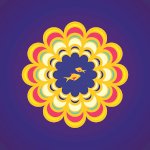Parsi New Year in India Date in the current year: August 16, 2025
 Parsis in India celebrate their New Year holiday in mid-August. In the states of Gujarat and Maharashtra, where most Indian Parsis live, the Parsi New Year is an official state holiday.
Parsis in India celebrate their New Year holiday in mid-August. In the states of Gujarat and Maharashtra, where most Indian Parsis live, the Parsi New Year is an official state holiday.Parsis (also spelled Parsees) are an ethnoreligious group of Zoroastrians who fled from Persia to the Indian subcontinent to escape persecution after the Arabian invasion of Iran in the 7th century. Before the Muslim conquest, Zoroastrianism was the dominant religion of Persia, but after the fall of the Sasanian Empire and the conquest of Persia by Arab Muslims, thousands of Zoroastrians migrated to India to avoid persecution and retain their religious and cultural identity.
Over the centuries since the arrival of the first Zoroastrians in India, the Parsis have integrated into Indian society while retaining their own customs and traditions (and, therefore, their ethnoreligious identity). Because of this, the Parsi community has a special place in Indian society: they are considered Indians in terms of history, language (most Parsis speak Gujarati or Hindustani as their first language) and national affiliation, but not typically Indian when it comes to ethnicity, cultural and religious practices, etc.
Interestingly, ethnic origin and religion are equally important for the Parsis: even if a person is descended from the original Persian refugees, they’re not considered a Parsi if they haven’t been formally admitted into the Zoroastrian religion. Children are inducted into Zoroastrianism through the navojte ceremony, which usually occurs after a child celebrates their seventh birthday but before they reach maturity. The Zoroastrians think that a person should be old enough to comprehend the significance of the ceremony, but not an adult yet.
As of 2014, there were 69,000 Parsis in India, and a little over a thousand Parsis lived in the neighboring Pakistan. Outside the Indian Subcontinent, there are significant Parsi communities in the United States, the United Kingdom (by the way, Freddie Mercury of Queen was Parsi), Canada, Sri Lanka, Singapore and Australia. The majority of Indian Parsis live in the states of Gujarat and Maharashtra, where, due to a significant Parsi population, the Parsi New Year (Nawroz) was even declared an official holiday.
Essentially, the Parsi New Year is the same holiday as Nowruz, which occurs on the day of the vernal equinox in the Northern Hemisphere. However, the Parsis celebrate it in August instead of March 21. The reason for it is that there are three distinct versions of Zoroastrian calendar, and the Parsis use the Shahanshahi calendar, where the first day of the new year doesn’t coincide with the vernal equinox. This calendar was introduced by King Jamshid (or Jamshed, as the Parsis spell it), so the Zoroastrians of India often call their New Year holiday Jamshēd-i Nawrōz.
Despite the significant difference in dates, the Parsi New Year is celebrated in almost the same way as Nowruz: before the holiday, the Parsis clean their houses, decorate them with flower garlands, cook traditional dishes and buy new clothes. On New Year’s day, they visit their relatives, friends and neighbors, welcome guests at their homes, pray for wealth, health and prosperity, repent for their sins, sing, dance, recite poetry, and exchange symbolic gifts.
- Category
- Religious Holidays, Cultural Observances
- Country
- India
- Tags
- Parsi New Year in India, holidays in India, religious holidays, cultural holidays, Zoroastrian holidays